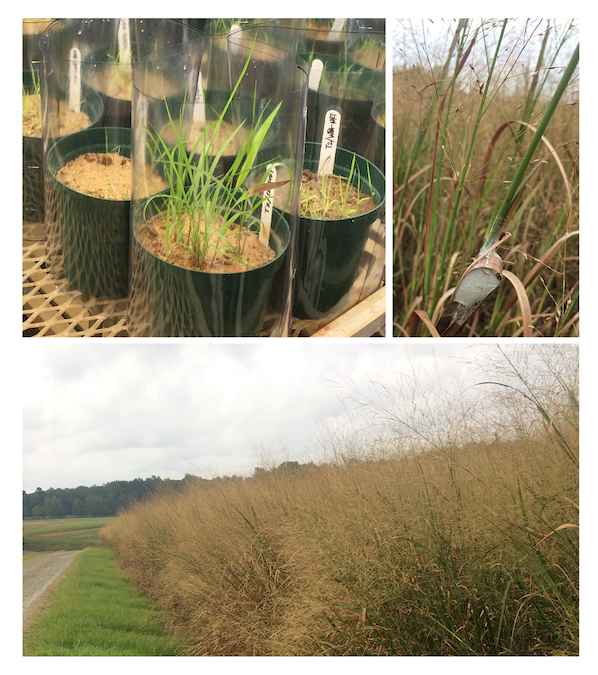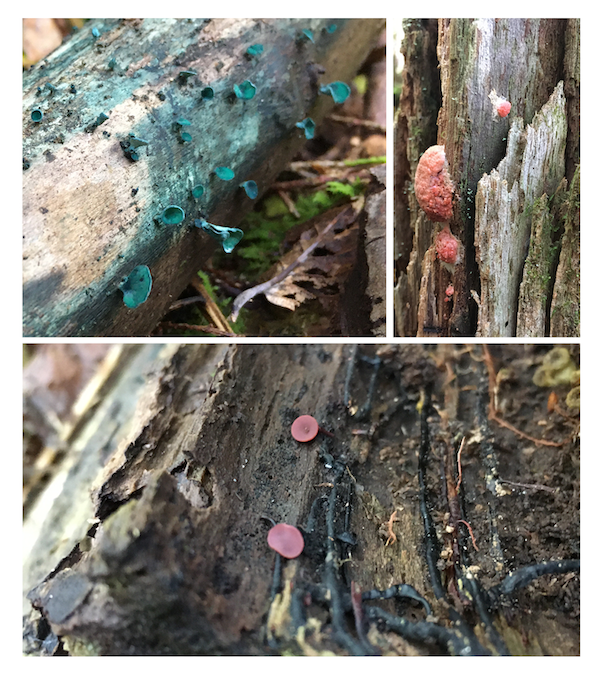Projects
Below are a few of the key projects that I have been involved in over the years. Although I have shifted between different systems - plant invasion, wood decay, biofuel production - a consistent theme has been my interest in how organisms and their interactions underpin healthy ecosystems.
Structure and function of the switchgrass microbiome
Motivation
Panicum virgatum (switchgrass) is a promising biofuel species that is potentially suitable for cultivation on marginal lands with low inputs. Microbes that live in close association with P. virgatum can have large impacts on its productivity; however, little is known about the diversity and function of these associations. To address this, we have surveyed leaf, root, and soil-associated microbes using molecular and culture-based methods and are currently evaluating plant responses to field-collected isolates.
Collaborators
Christine Hawkes (NCSU), Jennifer Pett-Ridge (LLNL), Rachel Hestrin (LLNL), Briana Whitaker (USDA-ARS)
Findings
Lee, M.R. & Hawkes, C.V. 2021. Widespread co-occurrence of Sebacinales and arbuscular mycorrhizal fungi in switchgrass roots and soils has limited dependence on soil carbon or nutrients. Plants, People, Planet, 00: 1-13. DOI: 10.1002/ppp3.10181
Hestrin, R., Lee, M.R., Whitaker, B.K., & Pett-Ridge, J. 2021. The switchgrass microbiome: A review of the structure, function, and taxonomic distribution. Phytobiomes, 00: 1-62. DOI: 10.1094/PBIOMES-04-20-0029-FI
Lee, M.R. & Hawkes, C.V. 2020. Plant and soil drivers of whole-plant microbiomes: variation in switchgrass fungi from coastal to mountain sites. Phytobiomes, 00: 1-11. DOI: 10.1094/PBIOMES-07-20-0056-FI

Microbial ecology of wood decay
Motivation
Communities of wood-dwelling fungi mediate tree health and wood decay and in doing so determine a significant portion of terrestrial fixed carbon gains and losses. Consequently, the trajectory of climate change depends in part on how these fungi respond to their environment and each other, so it is necessary to understand which factors mediate the assembly of fungi in wood tissue. To address this challenge, we are characterizing wood-dwelling fungal communities a range of wood species from woodlands in NSW, Australia and Missouri, USA.
Collaborators
Amy Zanne (GWU), Brad Oberle (NCF), Jeff Powell (WSU), Will Cornwell (UNSW)
Findings
Lee, M.R., Oberle, B., Olivas, W., Young, D.F., Zanne, A.E. 2020. Wood construction more strongly shapes deadwood microbial communities than spatial location over 5 years of decay. Environmental Microbiology 22(11): 4702-4717. DOI: 10.1111/1462-2920.15212
Lee, M.R., Powell, J.R., Oberle, B., Cornwell, W.K., Lyons, M., Rigg, J.L., & Zanne, A.E. 2019. Good neighbors aplenty: fungal endophytes rarely exhibit competitive exclusion patterns across a span of woody habitats. Ecology, 186(2): 281–15. DOI: 10.1002/ecy.2790
Oberle, B., Lee, M.R., Myers, J.A., Osazuwa-Peters, O.L., Spasojevic, M.J., Walton, M.L., Young, D.F., Zanne, A.E. 2019. Accurate forest projections require long‐term wood decay experiments because plant trait effects change through time. Global Change Biology, 26(2: 864-875. DOI: 10.1111/gcb.14873.

Plant invasions & nutrient cycling
Motivation
Species can be important actors that mediate ecosystem processes critical to human and ecosystem health, e.g. soil carbon storage, nutrient retention and clean water. But it is difficult to determine who the important actors are and in which contexts. Using model-organism and meta-analytical approaches, I addressed the following questions: (1) Does a plant invader’s nutrient-use strategy predict its impact on nutrient retention and loss? (2) How do the primary forms of nutrients utilized by plants and microbes in an ecosystem mediate a plant invader’s impact? (3) Which is a better predictor of a plant invader’s impact – its abundance or the degree to which it is novel in the invaded system?
Collaborators
Justin Wright (Duke), Emily Bernhardt (Duke), Rich Phillips (IU), Luke Flory (UF)
Findings
Lee, M.R., Flory, S.L., Phillips, R.P., Wright, J.P. 2018. Site conditions are more important than abundance for explaining plant invasion impacts on soil nitrogen cycling. Ecosphere, 9(10) e02454. DOI: 10.1002/ecs2.2454
Lee, M.R., Bernhardt, E.S., van Bodegom, P.M., Cornelissen, J.H.C., Kattge, J., Laughlin, D.C., Niinemets, U., Penuelas, J., Reich, P.B., Yguel, B., & Wright, J.P. 2016. Invasive species’ leaf traits and dissimilarity from natives shape their impact on nitrogen cycling: a meta-analysis. New Phytologist, 213(1): 128–139. DOI: 10.1111/nph.14115
Lee, M.R., Tu, C., Chen, X., Hu, S. 2014. Arbuscular mycorrhizal fungi enhance P uptake and alter plant morphology in the invasive plant Microstegium vimineum. Biological Invasions, 16: 1083–1093. DOI: 10.1007/s10530-013-0562-4
Lee, M.R., Flory, S.L., Phillips, R.P. 2012. Positive feedbacks to growth of an invasive grass through alteration of nitrogen cycling. Oecologia, 170:457–465. DOI: 10.1007/s00442-012-2309-9
